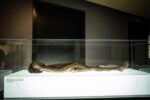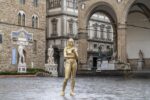Profanation: Ghenos Eros e Thanathos
.jpg)
Ghenos, Eros e Thanathos (o come lo chiamerebbe Alberto Boatto: GET) è stato probabilmente uno dei progetti più radicali e significativi dell’arte, non solo italiana, dal secondo dopoguerra a oggi. A distanza di quarantatré anni non ha perduto nulla del suo smalto, ha anzi acquisito nuove sfumature e profondità.
Comunicato stampa
Ghenos, Eros e Thanathos (o come lo chiamerebbe Alberto Boatto: GET) è stato probabilmente uno dei progetti più radicali e significativi dell’arte, non solo italiana, dal secondo dopoguerra a oggi. A distanza di quarantatré anni non ha perduto nulla del suo smalto, ha anzi acquisito nuove sfumature e profondità. Il desiderio di Paolo Chiasera, mio e della galleria, di lavorare sull’idea di Boatto nasce proprio da questo: è impossibile ridurre GET a una qualsiasi importanza storica del tempo in cui è stata realizzata, non ha nulla di datato. Nel corso degli anni la mostra e il testo che la accompagnava hanno bensì aumentato il loro portato rivoluzionario, capace ancora oggi di presentarsi come una “pietra oscura”, un “edificio insondabile” e profondo, fastidioso e impossibile da osservare a lungo. Non a caso Boatto lo aveva costruito attorno ai tre semplici mattoni di cui è fatta la natura umana, il momento della nascita, l’eros e la morte, su cui poi viene appoggiato tutto il resto, e in cui la testata d’angolo del suo discorso veniva occupata dal Thanatos. I settanta erano anni di fede radicale in ideologie astruse, lontane dalla realtà e pericolose. Scegliere di fare una mostra così poco politica (intendendo “politica” nel senso più banale del termine) non deve essere stato facile, e immagino le critiche che può aver generato. Oggi viviamo anni di nichilismo peloso e verboso che si riversa anche nel mondo dell’arte, ma il risultato finale è sempre lo stesso: le mostre, le biennali, gli artisti trattano troppo spesso tematiche lontane dalla realtà, dalla tangibilità dei fatti che influenzano direttamente la nostra vita, i nostri corpi, la concretezza dell’esistenza e dei suoi avvenimenti basici. Siamo inondati di trattati su post fordismo, post colonialismo, il design degli anni sessanta, il modernismo degli anni trenta, indagini su spaccati sociali e antropologici; e abbiamo anche il coraggio di lamentarci se il pubblico dell’arte è così misero rispetto a quello degli altri linguaggi. E’ forse allora ancora più rivoluzionario oggi presentare queste tre istanze base, attorno a cui veramente si muovono le nostre vite e rispetto alle quali tutto il resto deve muoversi come funzionale e secondario. Alberto Boatto se ne è andato poco tempo fa, lasciandoci un’ultima testimonianza scritta che accompagna questo progetto di mostra come una guida, una stella. Assieme a questo testo e al libro pubblicato nel 1974, la mostra che lui fece è la base da cui siamo partiti a lavorare con Paolo, e da lui sarà reintegrata quasi fosse una visione magicamente rievocata e riportata in vita in una sua grande installazione che farà da spazio curatoriale e visiva per tutte le altre opere che verranno presentate. Si tratta di lavori di artisti delle ultime generazioni, che condividono lo spirito della mostra del 1974 e che si relazionano con le opere esposte allora, rigenerandole, pervertendole, e mostrando che esiste sempre una nuova vita per l’arte dopo la morte.
Antonio Grulli
PROFANATION: GHENOS EROS THANATOS
CURATORIAL CHANNELERS: PAOLO CHIASERA and ANTONIO GRULLI
ARTISTS: DAVID ADAMO – VAJICO CHACHKHIANI – KEREN CYTTER – RICCARDO PREVIDI - ANCA MUNTENAU RIMNIC – MATHILDE ROSIER
OPENING: FRIDAY , MARCH 24, 2017 – 6:00 PM
ON VIEW FROM 03/25/17 TO 05/26/2017
Ghenos Eros Thanathos (or as Alberto Boatto called it, GET) can still be seen as one of the most radical, seminal artistic projects since World War II, in Italy and beyond. Forty-three years later, it has lost none of its luster, and if anything has taken on new shades of depth. This is what moved Paolo Chiasera, the gallery, and me to work with Boatto’s idea: GET cannot be reduced to its historical importance at the time it was made, since there is nothing dated about it. Over the years, the revolutionary significance of this exhibition and the text that accompanied it has only increased, even today standing as a “dark gem,” an “unfathomable edifice” that is profound, troubling, and impossible to observe at length. Not coincidentally, Boatto built his show around the three basic elements in human life: birth, eros, and death, which serve as the foundation for everything else, with Thanatos as the cornerstone of his discourse. The 1970s were years of radical faith in abstruse ideologies, dangerously detached from reality. Choosing to do such an apolitical exhibition (in the ordinary sense of “politics”) could not have been easy, and I can imagine the criticism it must have sparked. Today, we are living in a time of verbose, self-serving nihilism that overflows into the art world, but the end result is still the same: exhibitions, biennials, and artists that all too often deal with themes divorced from the real world, from the tangible things that directly influence our lives, our bodies, the concrete nature of existence and its key events. We are up to our knees in treatises on post-Fordism, post-colonialism, ’60s design, ’30s modernism, social and anthropological microstudies; yet we have the nerve to complain about art having such a slim audience compared to other creative languages. So today it is perhaps even more revolutionary to focus on these three basic impulses around which our lives truly revolve, compared to which everything else becomes ancillary. Alberto Boatto passed away not long ago, leaving one final piece of writing that guides this project like a lodestar. Along with this text and the book published in 1974, the exhibition he made is the basis from which we started out; as if magically channeling its vision and restoring it to life, Paolo will bring it back in the form of a major installation that will become a curatorial and visual framework for all the other works on view. These are by artists of later generations who share in the spirit of the 1974 exhibition and forge a dialogue with the pieces that were originally shown, regenerating them, subverting them, and proving that for art there is always a new life after death.
Antonio Grulli



